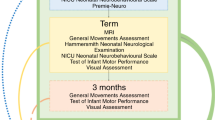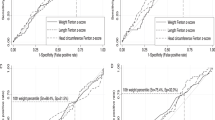Abstract
Objective
To evaluate TIMP in preterm very low birth weight (VLBW) infants, analyze risk factors, for atypical TIMP (aTIMP) scores, and explore TIMP’s predictive relationship with Bayley-III at 2 years.
Method
A prospective study of 288 VLBW infants, with TIMP assessment between 34 weeks postmenstrual age and 16 weeks age, corrected for prematurity.
Result
aTIMP scores were observed in 58/288(20%) infants, whose mean birth weight (BW) and gestational age were 1122 ± 257 g and 29.2 ± 2.12 weeks respectively. Risk factors included BW < 750 g (OR 4.8, 95% CI 1.3–17.7) and 750–1000 g (OR 2.9, 95% CI 1.2–6.9), presence of necrotizing enterocolitis ≥ stage 2; or focal intestinal perforation (OR 4.6, 95% CI 1.4–14.4), periventricular leukomalacia (OR 22.4,95% CI 2.0–246.2), and need for intensive resuscitation at birth (OR 2.7, 95% CI 1.3–5.5).
aTIMP scores correlated with Bayley-III Score <85 in motor and cognitive domains with high specificity (80–82%) and negative predictive value (85–94%).
Conclusion
Identification of the risk factors for aTIMP scores will enable targeted intervention to optimize resources and outcomes in VLBW infants.
This is a preview of subscription content, access via your institution
Access options
Subscribe to this journal
Receive 12 print issues and online access
$259.00 per year
only $21.58 per issue
Buy this article
- Purchase on Springer Link
- Instant access to full article PDF
Prices may be subject to local taxes which are calculated during checkout

Similar content being viewed by others
References
Bracewell M, Marlow N. Patterns of Motor Disability in Very Preterm Children. Ment Retard Dev Disabil Res Rev. 2002;8:241–8.
Van Hus J, Jeukens-Visser M, Koldewijn K, Holman R, Kok JH, Nollet F, et al. Early intervention leads to long-term developmental improvements in very preterm infants, especially infants with bronchopulmonary dysplasia. Acta Pediatr. 2016;105:773–81.
Spittle A, Orton J, Anderson PJ, Boyd R, Doyle LW. Early developmental intervention programmes provided post hospital discharge to prevent motor and cognitive impairment in preterm infants. Cochrane Database Syst Rev. 2015:CD005495.
Rosenbaum P. Variation and “abnormality”: recognizing the differences. J Pediatr. 2006;149:593–4.
Johnson S, Marlow N. Developmental screen or developmental testing? Early Hum Dev. 2006;82:173–83.
Spittle AJ, Doyle LW, Boyd RN. A systematic review of the clinimetric properties of neuromotor assessments for preterm infants during the first year of life. Dev Med Child Neurol. 2008;50:254–66.
Noble Y, Boyd R. Neonatal assessments for the preterm infant up to 4 months corrected age: a systematic review. Dev Med Child Neurol. 2012;54:129–39.
Campbell SK, Kolobe TH, Wright BD, Linacre JM. Validity of the Test of Infant Motor Performance for prediction of 6−,9 - and 12-month scores on the Alberta infant Motor Scale. Dev Med Child Neurol. 2002;44:263–72.
Kolobe TH, Bulanda M, Susman L. Predicting motor outcome at preschool age for infants tested at 7, 30, 60, and 90 days after term age using the Test of Infant Motor Performance. Phys Ther. 2004;84:1144–56.
Kim SA, Lee YJ, Lee YG. Predictive Value of Test of Infant Motor Performance for Infants based on Correlation between TIMP and Bayley Scales of Infant Development. Ann Rehabil Med. 2011;35:860–6.
Volpe JJ. Brain injury in premature infants: a complex amalgam of destructive and developmental disturbances. Lancet Neurol. 2009;8:110–24.
Peyton C, Schreiber MD, Msall ME. The Test of Infant Motor Performance at 3 months predicts language, cognitive, and motor outcomes in infants born preterm at 2 years of age. Dev Med Child Neurol. 2018;60:1239–43.
Agarwal P, Sriram B, Rajadurai V. Neonatal outcome of extremely preterm Asian infants ≤ 28 weeks over a decade in the new millennium. J Perinatol. 2015;35:297–303.
Campbell SK. The Test of Infant Motor Performance. Test User’s Manual Version 5. Chicago: Infant Motor Performance Scales, LLC; 2012.
Albuquerque PL, Guerra MQF, Lima MC, Eickmann SH. Concurrent validity of the Alberta Infant Motor Scale to detect delayed gross motor development in preterm infants: a comparative study with the Bayley III. Dev Neurorehabil. 2018;21:408–14.
Flegel J, Kolobe TH. Predictive validity of the test of infant motor performance as measured by the Bruininks-Oseretsky test of motor proficiency at school age. Phys Ther. 2002;82:762–71.
Hickey M, Georgieff M, Ramel S. Neurodevelopmental outcomes following necrotizing enterocolitis. Semin Fetal Neonatal Med. 2018;23:426–32.
Lee EJ, Han JT, Lee JH. Risk factors affecting Tests of Infant Motor Performance (TIMP) in pre-term infants at post-conceptional age of 40 weeks. Dev Neurorehabil. 2012;15:79–83.
Campbell SK, Hedeker D. Validity of the Test of infant motor performance for discriminating among Infants with varying risk for poor motor outcome. J Pediatr. 2001;139:546–51.
Vohr BR, Msall ME. Neuropsychological and functional outcomes of very low birth weight infants. Semin Perinatol. 1997;21:202–20.
Barbosa VM, Campbell SK, Smith E, Berbaum M. Comparison of test of infant motor performance (TIMP) item responses among children with cerebral palsy, developmental delay, and typical development. Am J Occup Ther. 2005;59:446–56.
Barbosa VM, Campbell SK, Berbaum M. Discriminating infants from different developmental outcome groups using the Test of Infant Motor Performance (TIMP) item responses. Pediatr Phys Ther. 2007;19:28–39.
Aylward GP. Update on neurodevelopmental outcomes of infants born prematurely. J Dev Behav Pediatr. 2014;35:392–94.
Diamond A. Close interrelation of motor development and cognitive development and of the cerebellum and prefrontal cortex. Child Dev. 2000;71:44–56.
Aylward GP. Neurodevelopmental outcomes of infants born prematurely. J Dev Behav Pediatr. 2005;26:427–40.
Song YH, Chang HJ, Shin YB, Park YS, Park YH, Cho ES. The validity of two neuromotor assessments for predicting motor performance at 12 months in preterm infants. Ann Rehabil Med. 2018;42:296–304.
Picciolini O, Giannì ML, Vegni C, Fumagalli M, Mosca F. Usefulness of an early neurofunctional assessment in predicting neurodevelopmental outcome in very low birth weight infants. Arch Dis Child Fetal Neonatal Ed. 2006;91:F111–F117.
Author information
Authors and Affiliations
Corresponding author
Ethics declarations
Conflict of interest
The authors declare no competing interests.
Additional information
Publisher’s note Springer Nature remains neutral with regard to jurisdictional claims in published maps and institutional affiliations.
Rights and permissions
About this article
Cite this article
Madayi, A., Shi, L., Zhu, Y. et al. The Test of Infant Motor Performance (TIMP) in very low birth weight infants and outcome at two years of age. J Perinatol 41, 2432–2441 (2021). https://doi.org/10.1038/s41372-021-01067-w
Received:
Revised:
Accepted:
Published:
Issue Date:
DOI: https://doi.org/10.1038/s41372-021-01067-w



